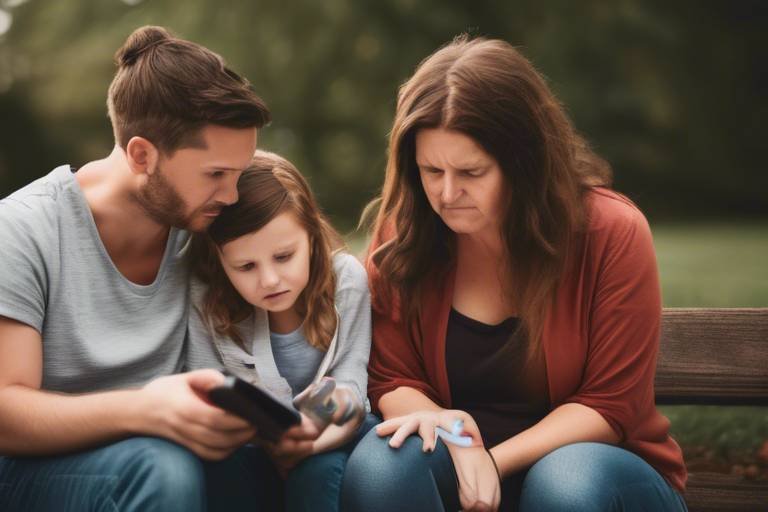Home Schooling: Incorporating Health Education in Your Curriculum
Home schooling is not just about academic subjects; it's a holistic approach that encompasses all aspects of a child's development. One of the most crucial components that often gets overlooked is health education. Why is it so important, you ask? Well, health education equips children with the knowledge and skills they need to make informed decisions about their well-being. It covers a wide range of topics, including nutrition, physical activity, mental health, and even social well-being. In a world where children are bombarded with information from various sources, having a solid foundation in health education can empower them to navigate these waters confidently.
Integrating health education into your home schooling curriculum is not just beneficial; it’s essential. Think of it as laying down the tracks for a train; without those tracks, the train can't move forward. Similarly, without a strong understanding of health, children may struggle to make choices that positively impact their lives. This article will guide you through the significance of incorporating health education into your home schooling approach and provide you with practical strategies to do so effectively.
At its core, health education is about teaching children the importance of making healthy choices and understanding the factors that contribute to their overall well-being. It's about more than just saying "eat your vegetables"; it's about instilling a lifelong appreciation for nutrition, physical activity, and mental health. When children learn about these topics, they are better equipped to take care of themselves as they grow older.
In a home schooling context, health education can be tailored to fit your child's unique learning style and interests. For instance, if your child enjoys cooking, you can incorporate lessons on nutrition by involving them in meal preparation, discussing the benefits of various foods, and exploring recipes that promote healthy eating. Alternatively, if your child is more active, you can focus on physical education through fun activities, sports, and exercises that keep them engaged.
Creating a comprehensive health education curriculum requires careful planning and creativity. You want to ensure that your curriculum not only meets educational standards but also engages your child in a way that makes learning enjoyable. Start by identifying the key topics you wish to cover, such as nutrition, exercise, mental health, and hygiene. From there, you can develop lesson plans that incorporate a variety of teaching methods, including hands-on activities, discussions, and multimedia resources.
Establishing clear learning objectives is crucial for effective teaching. When you set specific goals, you create a roadmap for both you and your child. These objectives should align with your child's health education needs and interests, making the learning process more relevant and engaging. For example, if your child has a keen interest in sports, you might set an objective around understanding the importance of hydration and nutrition for athletic performance.
Short-term objectives help measure progress in health education. These can be specific, measurable goals that can be achieved within a few weeks or months. For instance, you might aim for your child to learn about five different food groups and their benefits over the course of a month. This approach allows you to celebrate small victories along the way, keeping motivation high.
Long-term objectives guide overall educational outcomes. These broader goals can encompass a child's comprehensive understanding of health over time. For example, a long-term objective might be for your child to develop a balanced lifestyle that includes regular physical activity and healthy eating habits. This kind of goal encourages ongoing learning and personal growth, rather than a one-time lesson.
Utilizing diverse teaching methods can enhance learning experiences. Kids often learn best when they are actively involved in the process. Consider incorporating interactive activities such as cooking classes, gardening, or even community sports. These hands-on experiences will not only make health education more enjoyable but also help solidify the concepts in your child's mind.
Incorporating games, quizzes, and even technology can also make learning about health fun. For example, you can use apps that track physical activity or nutrition, turning learning into a game that your child can enjoy. The key is to keep the learning process dynamic and engaging, so your child remains excited about health education.
Access to quality resources is essential for effective home schooling. Luckily, there are countless books, websites, and community programs that can support your health education curriculum. Look for age-appropriate books that cover various health topics, as well as websites that offer interactive lessons and activities.
In our digital age, online tools can facilitate learning in health education. Websites like Khan Academy and Healthy Kids offer interactive content and lessons designed for children. These platforms can help supplement your teaching and provide a wealth of information at your fingertips.
Engaging with the community can enrich the home schooling experience. Consider reaching out to local health professionals, such as nutritionists or fitness trainers, who might be willing to conduct workshops or provide resources. Involving local organizations can also open doors to community events that promote health and wellness, offering your child real-world applications of what they learn.
- What age should health education start? Health education can begin as early as preschool, focusing on basic concepts of nutrition and hygiene.
- How can I make health education fun? Incorporate games, hands-on activities, and technology to keep your child engaged and excited about learning.
- Are there specific resources for health education? Yes, websites, books, and community programs can provide valuable information and support for your curriculum.

Understanding Health Education
Health education is not just a subject; it’s a vital pillar that supports the growth and well-being of children. As parents who choose home schooling, you have the incredible opportunity to shape your child’s understanding of health and wellness in a way that resonates with their unique learning styles. Think of health education as a toolkit, equipping your children with the knowledge they need to make informed decisions about their bodies, minds, and overall lifestyle.
At its core, health education encompasses a variety of topics, including nutrition, physical activity, and mental health. Each of these elements plays a crucial role in a child’s development. For instance, understanding nutrition helps children make healthier food choices, while knowledge about physical activity encourages them to stay active and engaged. Moreover, mental health education fosters emotional intelligence, teaching kids how to manage stress and develop resilience.
In a home schooling context, the importance of health education cannot be overstated. Unlike traditional schooling, where health topics might be glossed over or integrated into other subjects, home schooling allows for a more focused and tailored approach. You can dive deep into topics that your child is particularly interested in, making learning both engaging and relevant. For example, if your child shows an interest in cooking, you could incorporate lessons on healthy eating by preparing nutritious meals together, thus making education a hands-on experience.
Moreover, health education is not just about imparting knowledge; it’s about fostering lifelong habits. When children learn about the importance of a balanced diet and regular exercise early on, they are more likely to carry those habits into adulthood. It’s like planting a seed; with the right nurturing, it can grow into a strong tree that bears fruit for years to come.
To effectively integrate health education into your home schooling curriculum, consider the following foundational concepts:
- Holistic Approach: Addressing the physical, emotional, and social aspects of health.
- Interactive Learning: Using games, activities, and discussions to make learning enjoyable.
- Real-Life Application: Relating health topics to everyday situations to enhance understanding.
In conclusion, understanding health education is essential for parents who home school. It empowers children with the knowledge and skills they need to lead healthy lives. By making health education a priority, you’re not just teaching your children; you’re investing in their future. So, roll up your sleeves, get creative, and watch as your children thrive in their journey towards health and wellness!

Curriculum Development
Creating a comprehensive health education curriculum for home schooling is not just about filling in the blanks; it’s about weaving together a tapestry of knowledge that will serve your child for a lifetime. Think of it as planting a garden—each subject is like a seed that, with the right care and attention, will grow into a robust understanding of health and wellness. To achieve this, you need to consider various elements that contribute to an engaging and informative curriculum.
First and foremost, it’s essential to align your curriculum with educational standards while also catering to your child's unique interests and learning style. This means you should incorporate topics that are not only relevant but also intriguing to your child. For instance, if your child shows a keen interest in cooking, you could delve into nutrition by exploring healthy recipes and the science behind food. This approach not only makes learning enjoyable but also encourages active participation.
Another critical aspect of curriculum development is the incorporation of practical activities. Engaging your child in hands-on experiences can significantly enhance their understanding of health concepts. For example, you might organize a weekly physical activity day where your child can try different sports or outdoor activities. This not only promotes physical health but also teaches valuable lessons about teamwork and perseverance.
To ensure that your curriculum is well-rounded, consider integrating various teaching methods. A blend of visual, auditory, and kinesthetic learning styles can cater to different preferences. For instance, you might use videos and documentaries to explain complex health issues, while also incorporating discussions and debates to stimulate critical thinking. This diverse approach will keep your child engaged and make the learning process more dynamic.
When developing your curriculum, it’s also beneficial to set a timeline. This will help you stay organized and ensure that all necessary topics are covered within a reasonable timeframe. Consider breaking the curriculum into units, each focusing on a specific theme such as nutrition, physical activity, mental health, and hygiene. You could create a simple table to outline your curriculum timeline:
| Unit | Topic | Duration |
|---|---|---|
| 1 | Nutrition Basics | 2 weeks |
| 2 | Physical Activity | 3 weeks |
| 3 | Mental Health Awareness | 2 weeks |
| 4 | Personal Hygiene | 1 week |
Lastly, don't forget to incorporate assessments to measure your child's progress. These can be informal, such as discussions or presentations, or formal, like quizzes and projects. The key is to provide constructive feedback that encourages growth and understanding. Remember, the goal of health education is not merely to pass a test but to instill lifelong habits and knowledge that will benefit your child in the long run.
In conclusion, developing a health education curriculum for home schooling is an exciting journey that requires creativity, planning, and adaptability. By focusing on engaging content, practical experiences, and a variety of teaching methods, you can create a rich learning environment that empowers your child to take charge of their health and well-being.
- What are the essential components of a health education curriculum? A well-rounded curriculum should include topics like nutrition, physical activity, mental health, and personal hygiene.
- How can I make health education fun for my child? Incorporate hands-on activities, games, and real-life applications to keep your child engaged and interested.
- How do I assess my child's understanding of health topics? Use a mix of informal discussions, presentations, and formal quizzes to gauge their knowledge and understanding.

Setting Learning Objectives
When it comes to teaching health education at home, setting clear learning objectives is absolutely essential. Think of these objectives as the road signs guiding your child through the vast landscape of health knowledge. Without them, they might feel lost, unsure of where they are headed or what they should be focusing on. So, how do you establish these objectives? It starts with understanding your child’s current level of knowledge and their interests. Are they curious about nutrition, or do they want to learn more about mental health? Tailoring your objectives to their needs not only makes learning more relevant but also significantly boosts their engagement.
One effective approach to setting these objectives is to categorize them into short-term and long-term goals. Short-term objectives can serve as stepping stones, helping your child build confidence and knowledge progressively. For instance, if you're focusing on nutrition, a short-term objective might be for your child to learn about the food pyramid and identify healthy snacks. On the other hand, long-term objectives can encompass broader themes, such as understanding the importance of a balanced diet and how it contributes to overall health. These long-term goals can guide your curriculum over weeks or even months, ensuring a comprehensive grasp of health topics.
To make this process easier, consider using a table to map out these objectives. Here’s a simple example:
| Objective Type | Specific Objective | Time Frame |
|---|---|---|
| Short-term | Identify 5 healthy snacks | 1 week |
| Long-term | Understand the importance of a balanced diet | 3 months |
By visualizing your objectives in this way, you create a clear roadmap for both you and your child. Remember, it's not just about what they learn but how they learn it. Incorporating interactive elements, such as cooking healthy meals together or visiting a local farmer's market, can make these objectives even more engaging. After all, learning about health should be as enjoyable as it is informative!
Lastly, don't forget to revisit and revise these objectives as your child progresses. Just like any good adventure, flexibility is key. If you notice that they are particularly fascinated by a specific topic, feel free to adjust your objectives to dive deeper into that area. This adaptability not only keeps the learning experience fresh but also fosters a love for health education that can last a lifetime.

Short-term Objectives
When it comes to teaching health education in a home schooling environment, play a pivotal role in measuring progress and ensuring that children grasp essential concepts. These objectives are like stepping stones that lead to a broader understanding of health and wellness. By focusing on specific, achievable goals, parents can create a structured learning path that keeps children engaged and motivated.
For instance, if your child is learning about nutrition, a short-term objective could be to understand the food pyramid and identify different food groups. This not only makes the learning process interactive but also allows children to apply their knowledge in real-life situations, such as planning a healthy meal. Another example might involve physical activity; setting a goal for your child to participate in a certain number of minutes of exercise each week can foster a habit of regular physical fitness.
To make these objectives more tangible, consider incorporating measurable outcomes. For example, you might set a goal for your child to try at least three new fruits or vegetables each week. This way, you can track progress and celebrate achievements, reinforcing positive behavior. Here’s a simple table that illustrates how to structure these short-term objectives:
| Health Topic | Short-term Objective | Measurement Criteria |
|---|---|---|
| Nutrition | Identify food groups | Correctly label food items in a grocery store |
| Physical Activity | Engage in exercise | Complete 30 minutes of activity at least 3 times a week |
| Mental Health | Practice mindfulness | Participate in a 5-minute meditation daily |
These short-term objectives not only provide clarity for both the parent and the child but also create a sense of achievement as each goal is met. It’s crucial to keep the atmosphere light and fun, turning learning into a game rather than a chore. Encourage your child to reflect on what they’ve learned at the end of each week, which can also enhance retention of the information.
Moreover, as you set these short-term objectives, remember to align them with your child’s interests. If they are passionate about sports, you might focus on the importance of hydration and recovery. If they love cooking, dive into the nutritional value of different ingredients. The more relevant the objectives are to their lives, the more engaged they will be in the learning process.

Long-term Objectives
When it comes to health education in home schooling, establishing is essential for fostering a comprehensive understanding of health and wellness in children. These objectives serve as a roadmap, guiding parents and children through the journey of learning about various aspects of health over time. But what exactly do these long-term objectives look like? Well, they should encompass a wide range of health topics, ensuring that children not only learn about nutrition and physical activity but also delve into mental health, emotional well-being, and the importance of healthy relationships.
Think of long-term objectives as the big picture goals that inform short-term learning activities. For instance, if one of your long-term objectives is to instill a deep understanding of nutrition, you might explore topics such as food groups, balanced diets, and the impact of nutrition on overall health. This can be broken down into specific lessons, but the overarching aim is to ensure that children grasp the importance of making healthy food choices throughout their lives.
Another crucial aspect of long-term objectives is that they should be adaptable. As children grow, their interests and needs may change, and your health education curriculum should reflect that. For example, as a child matures, you might shift the focus from basic nutrition to more complex topics like understanding food labels, cooking skills, and meal planning. This adaptability not only keeps the learning relevant but also helps children develop critical thinking skills as they navigate their health choices.
To illustrate this, consider the following table that outlines potential long-term objectives in health education:
| Health Topic | Long-term Objective |
|---|---|
| Nutrition | Understand the principles of balanced diets and the role of various food groups. |
| Physical Activity | Develop a lifelong appreciation for physical fitness and understand its benefits. |
| Mental Health | Recognize the importance of mental well-being and learn coping strategies for stress. |
| Healthy Relationships | Understand the characteristics of healthy relationships and effective communication skills. |
In addition to setting these objectives, it’s important to regularly assess progress toward achieving them. This can be done through discussions, projects, or even reflective journaling. By encouraging children to express what they’ve learned and how they can apply it in their daily lives, parents can reinforce the significance of health education. It’s all about creating a dialogue that promotes awareness and encourages children to take ownership of their health.
Ultimately, long-term objectives in health education are not just about imparting knowledge; they are about nurturing a holistic approach to health and wellness that children can carry with them into adulthood. By focusing on these enduring goals, parents can empower their children to make informed decisions and lead healthier lives.
- What are some effective ways to assess long-term objectives in health education? Regular discussions, projects, and reflective journaling can help gauge understanding and progress.
- How do I adapt the curriculum as my child grows? Keep the learning relevant by shifting focus to more complex topics as your child matures.
- Can long-term objectives change over time? Yes, they should be flexible to accommodate your child's evolving interests and needs.

Engaging Teaching Methods
When it comes to teaching health education at home, the key is to make learning fun and interactive. Kids are naturally curious, and tapping into that curiosity can create a vibrant learning environment. Instead of sticking to traditional lectures, consider using a mix of teaching methods that cater to different learning styles. For instance, some children might thrive on visual aids, while others might prefer hands-on activities or discussions.
One effective way to engage children is through experiential learning. This approach allows students to learn by doing, which can be incredibly impactful in health education. For example, you could organize a cooking day where kids prepare healthy meals, learning about nutrition as they chop vegetables and measure ingredients. This not only teaches them about food but also instills valuable life skills. Plus, who doesn’t love a delicious meal at the end of a lesson?
Another engaging method is to incorporate games and challenges. You can create quizzes on health facts or even set up scavenger hunts that require children to find healthy foods in your local grocery store. By turning learning into a game, you’re making it less of a chore and more of an adventure. Children are more likely to remember what they learn when it’s wrapped up in a fun experience.
Additionally, utilizing multimedia resources can enhance the learning experience. Videos, podcasts, and interactive online platforms are fantastic tools for teaching complex health topics. For example, you might watch a documentary about healthy living and then have a discussion about it. This not only reinforces the information but also encourages critical thinking.
Finally, don’t underestimate the power of community involvement. Bringing in local health professionals, such as nutritionists or fitness trainers, for guest lectures can provide children with real-world insights. This interaction can spark interest and motivate them to take charge of their health. You could even arrange field trips to local farms or health clubs to see health education in action.
In summary, engaging teaching methods are essential for making health education relatable and enjoyable for home-schooled children. By diversifying your approach and incorporating fun, hands-on activities, you can help your children develop a lifelong appreciation for health and wellness.
- What are some effective hands-on activities for teaching health education?
Activities like cooking healthy meals, gardening, or conducting simple science experiments related to nutrition can be very effective. - How can I assess my child's understanding of health topics?
Consider using quizzes, discussions, or even practical projects where they can demonstrate what they've learned. - Are there specific resources you recommend for health education?
Look for reputable websites, educational apps, and local community programs that focus on health and wellness.

Resources for Home Schooling
When it comes to home schooling, having the right resources can make all the difference. Imagine trying to build a house without the right tools—frustrating, right? The same applies to educating your children at home. Quality resources not only support your teaching efforts but also keep your children engaged and excited about learning. So, what exactly can you use to enhance your home schooling experience?
First off, consider books. There are countless educational books available that cover a wide range of health topics, from nutrition to mental wellness. Look for books that are age-appropriate and interactive, as they can spark curiosity and encourage children to explore further. For example, you might find a book that combines storytelling with health facts, making it easier for your child to absorb the information.
Next, don't underestimate the power of websites. The internet is a treasure trove of information, and there are numerous educational platforms dedicated to health education. Websites like Khan Academy and Healthy Kids offer free resources, videos, and interactive lessons that can make learning about health fun and engaging. By integrating these online resources into your curriculum, you can provide your children with a diverse learning experience that caters to different learning styles.
Additionally, consider utilizing community programs. Many local health organizations offer workshops, seminars, and even classes focused on health education. This not only enriches your curriculum but also allows your children to interact with professionals in the field. Imagine your child learning about nutrition from a local chef or understanding physical fitness from a personal trainer! These experiences can provide practical insights that are often more impactful than textbook learning.
Moreover, don’t forget about online tools and platforms. There are several apps and websites designed specifically for home schooling families. For instance, platforms like Edmodo and ClassDojo offer interactive ways to track progress, assign tasks, and even communicate with other home schooling families. This sense of community can be incredibly beneficial, providing support and ideas for your health education curriculum.
Finally, consider creating a resource library at home. This could include printed materials, digital resources, and even physical items like measuring cups for cooking lessons or exercise equipment for physical health activities. Having a dedicated space for these resources not only organizes your teaching materials but also creates a stimulating environment for learning.
In summary, the resources available for home schooling are vast and varied. By leveraging books, websites, community programs, online tools, and creating a resource library, you can provide a comprehensive and engaging health education experience for your children. Remember, the goal is to make learning about health not just informative, but also enjoyable!
Q: What types of books are best for health education in home schooling?
A: Look for age-appropriate books that combine storytelling with educational content. Interactive books that encourage participation are also great choices.
Q: Are there specific websites you recommend for health education resources?
A: Yes! Websites like Khan Academy and Healthy Kids offer excellent free resources, videos, and interactive lessons tailored for children.
Q: How can I involve my local community in my home schooling efforts?
A: Consider reaching out to local health organizations for workshops or classes. You can also invite health professionals to speak to your children about various topics.
Q: What online tools can help me track my child's progress in health education?
A: Platforms like Edmodo and ClassDojo are great for assigning tasks, tracking progress, and connecting with other home schooling families.

Online Tools and Platforms
In today's digital age, have revolutionized the way we approach education, especially in the realm of home schooling. With a plethora of resources available at our fingertips, parents can effectively teach their children about health education through interactive and engaging methods. Imagine a world where learning about nutrition and physical fitness is as exciting as playing a video game! This is the power of technology in education.
From comprehensive lesson plans to interactive quizzes, these digital platforms provide a variety of content that caters to different learning styles. For instance, platforms like Khan Academy and Coursera offer courses that cover essential health topics, making it easy for parents to supplement their teaching. Furthermore, websites like Healthline and KidsHealth provide reliable information that can help children understand complex health concepts in a way that is relatable and easy to grasp.
One of the key benefits of using online tools is the ability to track progress and adapt learning paths based on individual needs. Many platforms come equipped with analytics that allow parents to monitor their child’s understanding of various health topics, identifying areas that may need additional focus. This personalized approach not only enhances learning but also boosts a child’s confidence as they see their progress over time.
Additionally, gamified learning experiences can be particularly effective in keeping children engaged. Websites like BrainPOP offer animated educational videos and quizzes that make learning about health topics fun and interactive. By incorporating elements of play, children are more likely to retain information and develop a genuine interest in their health and well-being.
Moreover, many online resources provide opportunities for collaboration and community interaction. Platforms such as Edmodo and Google Classroom allow parents to connect with other home-schooling families, share resources, and even participate in group activities. This sense of community can be invaluable, as it fosters social interaction and collaborative learning, which are essential components of a well-rounded education.
To summarize, the integration of online tools and platforms into your home schooling curriculum can dramatically enhance the teaching and learning experience in health education. The flexibility, engagement, and accessibility of these resources make them indispensable for parents seeking to provide their children with a comprehensive understanding of health and wellness.
Here’s a quick overview of some popular online tools and platforms for health education:
| Platform | Description | Key Features |
|---|---|---|
| Khan Academy | Offers free online courses on various subjects including health. | Interactive exercises, progress tracking, and video lessons. |
| BrainPOP | Educational platform with animated videos covering health topics. | Quizzes, games, and a fun learning environment. |
| KidsHealth | A trusted source for health information aimed at children. | Articles, videos, and interactive content tailored for kids. |
| Edmodo | A social learning platform that connects educators and students. | Group projects, resource sharing, and community interaction. |

Community Involvement
When it comes to home schooling, the idea of community involvement can be a game-changer for both parents and children. Imagine learning about health not just from textbooks, but through real-life experiences and interactions with professionals in the field. This approach can significantly enhance a child’s understanding of health education, making it more relatable and engaging. So, how can parents effectively integrate community resources into their health education curriculum?
First and foremost, reaching out to local health professionals can provide invaluable insights. For instance, inviting a nutritionist to discuss healthy eating habits or a fitness instructor to conduct a fun exercise session can create a dynamic learning environment. Kids often learn best through hands-on experiences, and nothing beats learning about nutrition while preparing a healthy meal or understanding physical fitness while participating in a group workout.
Moreover, community health organizations often have programs designed for educational purposes. These can include workshops, seminars, or even health fairs that focus on various aspects of health and wellness. Participating in such events not only broadens the scope of education but also fosters a sense of belonging and community among home-schooled children. They get to interact with peers, share experiences, and learn collectively, which can be incredibly enriching.
Another engaging way to involve the community is by organizing field trips. Visiting local farms to learn about where food comes from, or taking a trip to a health clinic to understand how healthcare works can spark curiosity and interest in health topics. These experiences can be turned into projects or presentations, encouraging children to reflect on what they’ve learned and share it with others.
Additionally, parents can establish partnerships with local schools or educational programs. Many schools are open to collaborating on projects or sharing resources, which can be beneficial for home-schooled children. This collaboration can lead to joint health education initiatives, such as community service projects that promote wellness, further solidifying the child's learning experience.
In conclusion, community involvement in health education not only enriches the curriculum but also creates a supportive network for home-schooled children. By connecting with local health professionals, participating in community programs, organizing field trips, and collaborating with schools, parents can provide a comprehensive and engaging health education experience that prepares their children for a healthy future.
- How can I find local health professionals to involve in my curriculum?
Start by researching local health clinics, hospitals, or community health organizations. Many professionals are eager to share their knowledge with children and may be willing to conduct workshops or talks. - What types of community programs are beneficial for health education?
Look for programs that focus on nutrition, fitness, mental health, and overall wellness. Community health fairs, workshops, and educational seminars are great options. - Are field trips really effective for learning about health?
Absolutely! Field trips provide hands-on learning experiences that can make health concepts more tangible and memorable for children. - How can I ensure my child is engaged during community activities?
Involve your child in the planning process. Let them choose activities that interest them, and encourage them to ask questions and participate actively during events.
Frequently Asked Questions
-
What is health education and why is it important for home-schooled children?
Health education is a vital part of a child's development, focusing on teaching them about nutrition, physical activity, and mental well-being. It's essential for home-schooled children because it equips them with the knowledge and skills they need to make informed decisions about their health. By incorporating health education into their curriculum, parents can foster a holistic understanding of wellness that benefits their children's overall growth.
-
How can I create an effective health education curriculum for my home-schooled child?
Creating an effective health education curriculum involves careful planning and consideration of your child's interests and needs. Start by setting clear learning objectives that are both short-term and long-term. Incorporate engaging teaching methods such as interactive activities, hands-on projects, and discussions to make the learning process enjoyable. Additionally, utilize available resources like books, websites, and community programs to enrich your curriculum.
-
What are some engaging teaching methods for health education?
Engaging teaching methods can include hands-on experiments, cooking healthy recipes together, or even outdoor activities that promote physical fitness. Incorporating games, quizzes, and visual aids can also make learning about health fun and memorable. Remember, the goal is to make the subject relatable and exciting, so your child stays motivated and interested.
-
What resources can I use for teaching health education at home?
There are plenty of resources available for teaching health education at home. Look for reputable books that cover various health topics, educational websites that offer interactive lessons, and local community programs that focus on health and wellness. Online platforms can also provide valuable tools and activities that can enhance your teaching experience.
-
How can I involve the community in my child's health education?
Involving the community can greatly enrich your child's learning experience. You can invite local health professionals to speak about their work, organize field trips to health facilities, or participate in community health events. This not only provides practical knowledge but also helps your child connect with real-world health issues and solutions.



















